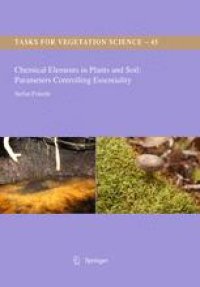
Ebook: Chemical Elements in Plant and Soil: Parameters Controlling Essentiality
Author: Stefan Fränzle (auth.)
- Tags: Plant Biochemistry, Analytical Chemistry, Inorganic Chemistry, Molecular Ecology, Environmental Monitoring/Analysis
- Series: Tasks for Vegetation Science 45
- Year: 2010
- Publisher: Springer Netherlands
- Edition: 1
- Language: English
- pdf
Earlier works on plant essential elements have revealed a series of complicated, counter-intuitive relationships among various chemical elements in different plant species, due to both unlike usage of certain elements in plants and to different carriers effecting resorption and transport.
In an attempt to provide a more coherent theory behind plant mineral nutrition, this groundbreaking book adopts a very different approach from the existing literature, presenting an explanation of the essentiality of chemical elements in biological systems and the application of stoichiometric network analysis (SNA) to the biological system of elements. Starting with data from biochemical environmental analysis, and a discussion of the phenomena involved in metal ion partition and autocatalytic behaviour, conditions and criteria controlling the partition of metals into biomass are investigated. Several rules are derived and investigated in terms of their interaction both in comparisons among contemporary organisms and in terms of evolution. This allows the construction, for example of a map which directly traces the biological feature of essentiality to parameters of coordination chemistry.
The book will have worldwide appeal for researchers interested in fields such as soil/plant interactions, bioinorganic chemistry, plant nutrition, phytomining, bioremediation, biogeochemistry, nutrient cycling, soil chemistry, and cellular physiology.
Earlier works on plant essential elements have revealed a series of complicated, counter-intuitive relationships among various chemical elements in different plant species, due to both unlike usage of certain elements in plants and to different carriers effecting resorption and transport.
In an attempt to provide a more coherent theory behind plant mineral nutrition, this groundbreaking book adopts a very different approach from the existing literature, presenting an explanation of the essentiality of chemical elements in biological systems and the application of stoichiometric network analysis (SNA) to the biological system of elements. Starting with data from biochemical environmental analysis, and a discussion of the phenomena involved in metal ion partition and autocatalytic behaviour, conditions and criteria controlling the partition of metals into biomass are investigated. Several rules are derived and investigated in terms of their interaction both in comparisons among contemporary organisms and in terms of evolution. This allows the construction, for example of a map which directly traces the biological feature of essentiality to parameters of coordination chemistry.
The book will have worldwide appeal for researchers interested in fields such as soil/plant interactions, bioinorganic chemistry, plant nutrition, phytomining, bioremediation, biogeochemistry, nutrient cycling, soil chemistry, and cellular physiology.
Earlier works on plant essential elements have revealed a series of complicated, counter-intuitive relationships among various chemical elements in different plant species, due to both unlike usage of certain elements in plants and to different carriers effecting resorption and transport.
In an attempt to provide a more coherent theory behind plant mineral nutrition, this groundbreaking book adopts a very different approach from the existing literature, presenting an explanation of the essentiality of chemical elements in biological systems and the application of stoichiometric network analysis (SNA) to the biological system of elements. Starting with data from biochemical environmental analysis, and a discussion of the phenomena involved in metal ion partition and autocatalytic behaviour, conditions and criteria controlling the partition of metals into biomass are investigated. Several rules are derived and investigated in terms of their interaction both in comparisons among contemporary organisms and in terms of evolution. This allows the construction, for example of a map which directly traces the biological feature of essentiality to parameters of coordination chemistry.
The book will have worldwide appeal for researchers interested in fields such as soil/plant interactions, bioinorganic chemistry, plant nutrition, phytomining, bioremediation, biogeochemistry, nutrient cycling, soil chemistry, and cellular physiology.
Content:
Front Matter....Pages i-viii
The Biological System of Elements....Pages 1-15
Autocatalytic Processes and the Role of Essential Elements in Plant Growth....Pages 17-130
A Causal Model of Biochemical Essentiality....Pages 131-151
The Evolution of Essentiality....Pages 153-179
Back Matter....Pages 181-196
Earlier works on plant essential elements have revealed a series of complicated, counter-intuitive relationships among various chemical elements in different plant species, due to both unlike usage of certain elements in plants and to different carriers effecting resorption and transport.
In an attempt to provide a more coherent theory behind plant mineral nutrition, this groundbreaking book adopts a very different approach from the existing literature, presenting an explanation of the essentiality of chemical elements in biological systems and the application of stoichiometric network analysis (SNA) to the biological system of elements. Starting with data from biochemical environmental analysis, and a discussion of the phenomena involved in metal ion partition and autocatalytic behaviour, conditions and criteria controlling the partition of metals into biomass are investigated. Several rules are derived and investigated in terms of their interaction both in comparisons among contemporary organisms and in terms of evolution. This allows the construction, for example of a map which directly traces the biological feature of essentiality to parameters of coordination chemistry.
The book will have worldwide appeal for researchers interested in fields such as soil/plant interactions, bioinorganic chemistry, plant nutrition, phytomining, bioremediation, biogeochemistry, nutrient cycling, soil chemistry, and cellular physiology.
Content:
Front Matter....Pages i-viii
The Biological System of Elements....Pages 1-15
Autocatalytic Processes and the Role of Essential Elements in Plant Growth....Pages 17-130
A Causal Model of Biochemical Essentiality....Pages 131-151
The Evolution of Essentiality....Pages 153-179
Back Matter....Pages 181-196
....